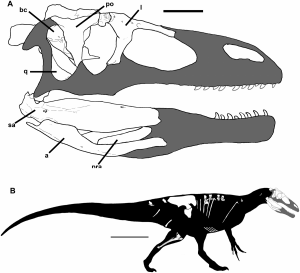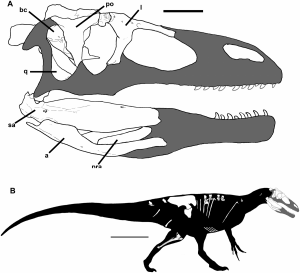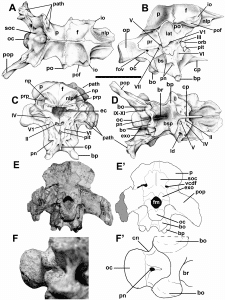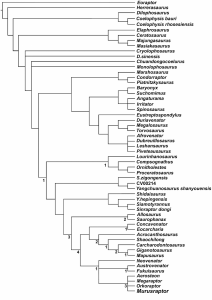
Sometimes, even when we can perfectly describe the preserved anatomy of a fossil animal, we still don’t always know where it falls on the tree of life. This is certainly true for South America’s newest dinosaur, Murusraptor barrosaensis, a new megaraptorid meat-eating dinosaur from the Late Cretaceous of Patagonia, South America, described recently by museum namesake Philip Currie and his colleague Rodolfo Coria, who led the study.
Murusraptor would have been an intimidating beast 90 million years ago when it hunted the South American landscape. About 6.5 metres long with a long low skull filled with serrated teeth and large curved claws on three-fingered hands, Murusraptor was the top predator in South America in its day. With its recent description, it’s now also one of the best known species in its family, the Megaraptoridae. However, despite the name, megaraptorids are likely only distantly related to dromaeosaurids, commonly known as “raptor” dinosaurs.

The known skeleton of Murusraptor barrosaensis from Coria and Currie (2016). Known bones are in white.
What group of dinosaurs megaraptorids are most closely related to, however, is uncertain. Some analyses of their relationships puts them as early offshoots of the line leading to T. rex, the tyrannosauroids. Other analyses more closely ally the group with the line of Jurassic meat-eater Allosaurus, the allosauroids.
I recently caught up with Phil Currie to ask him some questions about the new species, and here is what he had to say.
Q: Murusraptor has a very unique suite of features distinguishing it as a new species of meat-eating dinosaur. Can you talk about some of those features that make it so unique?
A: One of the biggest problems of trying to figure out an animal that’s a little bit different from anything else is who it’s related to. Megaraptor is an animal that was described in the 1990s and it was from 30 km away [from where the new dinosaur, Murusraptor, was found], and we realized very early on that Murusraptor was related to Megaraptor. But there was something wrong. For example, if you look at the size of the animal and the fact that they have very large arms, then you see that it’s an extension of what you see in Allosaurus. When you look at the shape of some of the bones in the hips, for example, you can see that it looked like a tyrannosaur. When you looked at the length the legs and at some of the characters associated with the skull, it looked like Spinosaurus. When you looked at the braincase [the part of the skull enclosing the brain] itself, it was just weird. It was something else altogether and nothing like anybody else had before.

The braincase (the bones of the skull around the brain) of Murusraptor. From Coria and Currie (2016). Photos and line drawings.
Q: How did you resolve the problem of what it’s most closely related to?
A: Because there are so many characters we use to relate animals together, we try to do it in an unbiased way, so it’s done by computer. The computer makes the decisions, but it’s still very much determined by what you put into the computer. So, you have to code everything. We wanted to produce a paper that had definitely resolved not just our animal, Murusraptor, but also all of the megaraptorids, but we realized that we were still not at the stage where we knew enough about certain parts of the skeleton or certain other animals, and our two analyses produced two different trees that seemed to both have a lot of support for them. So, we still weren’t happy with the results. We could have delayed the paper even longer, or we could just publish the best information we have right now. So, that’s what we did, but we still need to do a lot of work on this animal.

Strict consensus of 4650 most parsimonious phylogenetic trees of one of Coria and Currie’s (2016) analyses of species relationships. Note the Megaraptoridae mostly in an unresolved polytomy nested within the Allosauroidea at the bottom of the figure. From Coria and Currie (2016).
Q: As an Alberta palaeontologist, why do you get involved in these international projects, like in South America?
A: To me, palaeobiogeography [the study of where organisms lived in the fossil record] is always a fascinating thing because you learn a lot of things about your own animals, and it’s very easy for us to do work in Asia because the animals there are much more similar to the ones we have in Alberta, but when you get to the southern hemisphere, there’s things that are different, and those differences are caused in part by the separation between the continents and in part by the fact that you have a climatic barrier. Dinosaurs really weren’t equatorial animals, and moving across the equator wasn’t that easy for them. But in the Late Cretaceous, you start to see shifting of whole faunas that are moving into other areas. It’s fantastic to know that in the Late Cretaceous, a time that’s best-represented in Alberta, you start to see hadrosaurs occurring in South America. So, my interest has been that particular time period where the Alberta-style forms show up in South America. At the same time, South American dinosaurs get into North America. So, trying to figure out those little details and what’s causing these differences is a fascinating aspect of palaeontology.
For more information, you can read the open access publication over at PLOS ONE. You can also check out other blogs on the new find.
That’s all for now. Talk to you all again soon.
By Derek Larson
Reference: Coria RA, Currie PJ (2016) A New Megaraptoran Dinosaur (Dinosauria, Theropoda, Megaraptoridae) from the Late Cretaceous of Patagonia. PLoS ONE 11(7): e0157973. doi:10.1371/journal.pone.0157973
